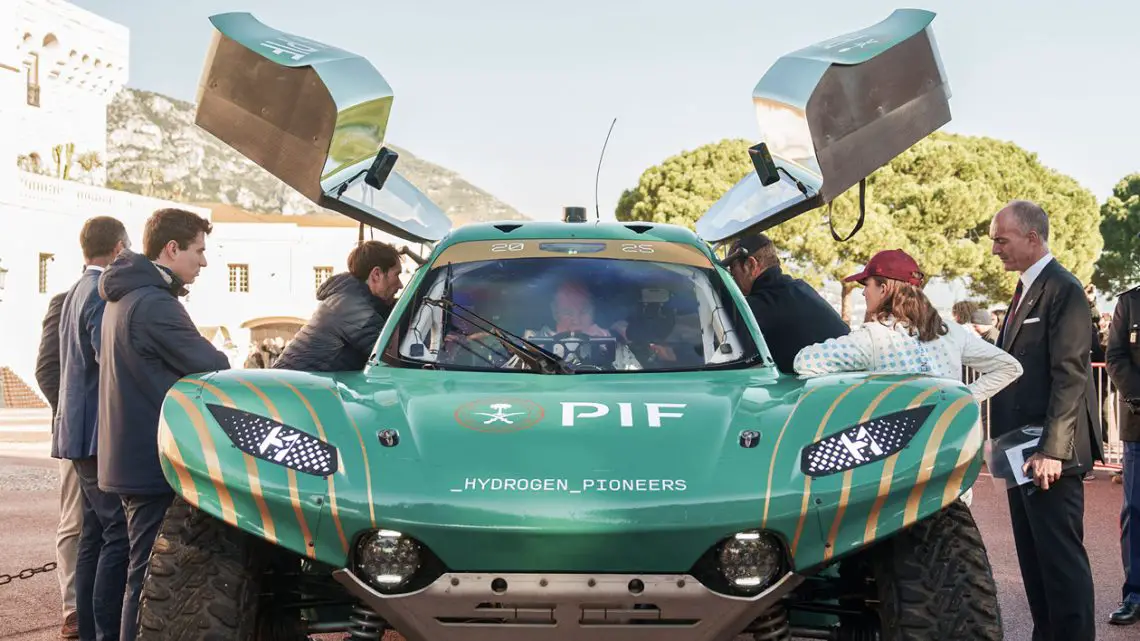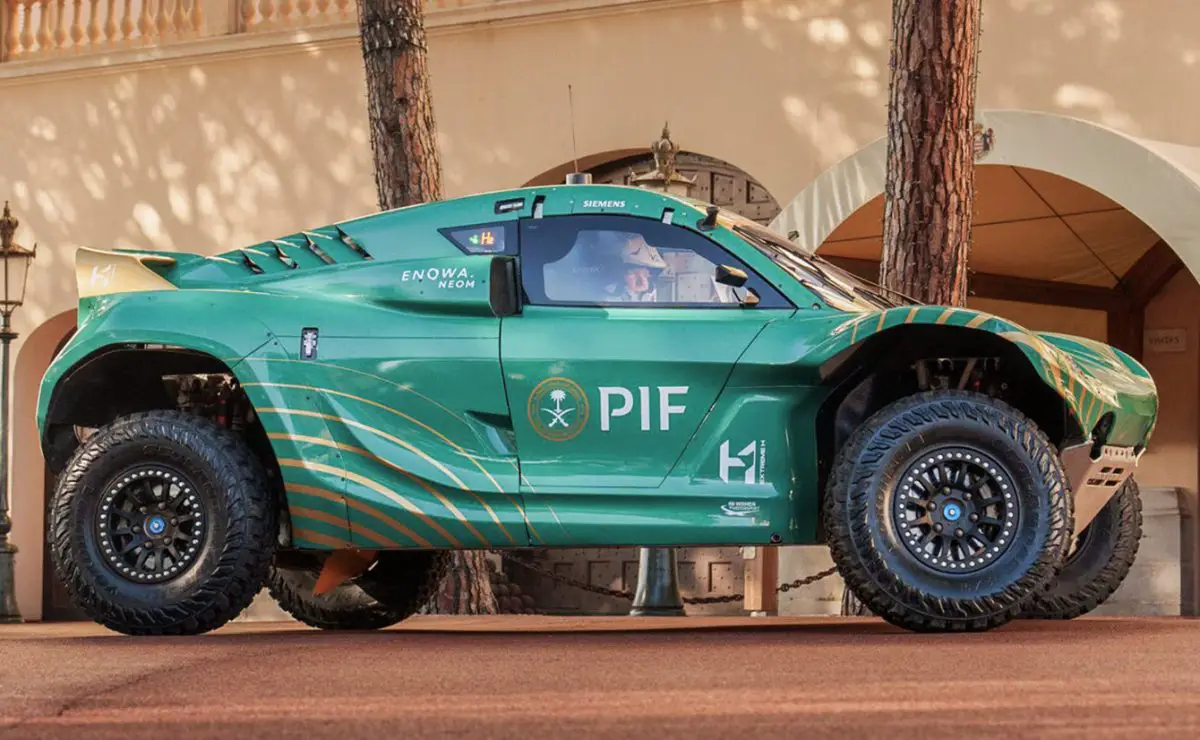
Prince Albert II Powers Through Monaco in a Hydrogen Race Car
December 2, 2024A Prince, a Race Car, and a Cleaner Future
H.S.H. Prince Albert II of Monaco showcased his steadfast commitment to clean energy innovation on a historic drive through the streets of Monaco. Behind the wheel of Extreme H’s hydrogen-powered prototype race car, the Pioneer 25, the Sovereign Prince reinforced the potential of hydrogen to transform the future of mobility and sustainability.
The drive, beginning at the Prince’s Palace of Monaco and concluding at the iconic Hotel Hermitage, came as the lead-up to the Monaco Hydrogen Alliance’s annual Forum. This event gathers global leaders to discuss hydrogen’s pivotal role in achieving net-zero goals.
Prince Albert II and Catie Munnings Unite to Showcase This Eye-catching Hydrogen Car
The Prince’s involvement highlighted hydrogen as a game-changing energy source. Following familiarization training with British race driver Catie Munnings, Prince Albert maneuvered the hydrogen race car along Monaco’s legendary streets, including paths that traditionally serve as battlegrounds for Formula One and Formula E.
Prince Albert emphasized the broader purpose behind the symbolic drive, stating, “Hydrogen represents an important pathway to a sustainable future, offering solutions to reduce emissions across multiple sectors. Innovation in motorsport can be a driving force for global progress, inspiring action far beyond the racetrack.”
By officially opening the Monaco Hydrogen Alliance Forum, the Prince ushered in a global stage for hydrogen advocacy. The event further cements Monaco’s role as a key hub for renewable energy collaboration.
Pioneer 25 and the Evolution of Hydrogen Racing
Extreme H’s Pioneer 25 prototype is a testament to cutting-edge engineering. Designed in partnership with leading hydrogen and motorsport innovators, the car represents the next step in sustainable racing. Key highlights include:
- Zero-emission hydrogen fuel cell technology developed by Symbio, replacing traditional batteries as the car’s primary energy source.
- 400 kW (550 hp) peak output, allowing the car to accelerate from 0-100 km/h in 4.5 seconds and scale gradients of up to 130%.
- Customization features allowing teams to modify front and rear bodywork, reflecting real-world automotive designs.
Symbio’s 75 kW fuel cell powers a battery pack supported trackside by Fortescue ZERO. Tested rigorously through an equivalent of three racing seasons, the Pioneer 25 is primed for its competitive debut when the Extreme H championship launches in 2025.
Extreme H builds on the electric racing legacy of Extreme E, pushing the boundaries of sustainable motorsport with hydrogen technology. Beyond just racing, Extreme H aims to demonstrate the capabilities of hydrogen innovations in addressing global challenges.
Hydrogen Motorsports Beyond Extreme H
Extreme H is not alone in harnessing hydrogen for racing innovation. Other initiatives also explore this path, demonstrating the broader potential of hydrogen technology. Among them:
- Toyota’s hydrogen-powered Corolla frequently competes in Japan’s Super Taikyu endurance races, powered by hydrogen combustion engines.
- Mission H24, a Le Mans-based project, is working on hydrogen-fueled prototypes with an eye on future endurance races.
- Hyraze League, a planned German racing series, combines hydrogen fuel cells with esports to promote sustainable automotive development.
- GreenGT, another Le Mans-affiliated effort, develops high-performance hydrogen-electric racing cars.
Such initiatives reflect the growing momentum behind hydrogen as both a competitor on the track and a solution to real-world environmental concerns.
Hydrogen’s Role in Modern and Future Mobility
Hydrogen’s role in motorsports transcends the racetrack. It acts as a testing ground for scalable applications across industries. Some of hydrogen’s advantages include:
- Renewable energy integration: Fuel cells can be powered by green hydrogen, produced using renewable energy sources like wind or solar power.
- Rapid refueling options: Compared to battery charging, hydrogen refueling is faster, enhancing practicality for various use cases.
- Decarbonization potential: Hydrogen can replace fossil fuels in sectors that are harder to electrify, such as aviation, shipping, and heavy-duty transportation.
To accelerate the widespread adoption of hydrogen, collaborative investment in production, distribution, and infrastructure is vital. Monaco’s initiative, spearheaded by forums like the Hydrogen Alliance, serves as an example for other nations to follow.
Applying Technology Today and Tomorrow
Hydrogen-powered technologies, like the Pioneer 25, highlight the real-world potential of emission-free transportation today. Cities equipped with hydrogen refueling stations have already begun integrating fuel cell-powered public transport, such as buses and municipal vehicle fleets. On a larger scale, hydrogen energy offers a viable, sustainable alternative for logistics companies managing heavy-duty transportation.
Looking to the future, advancements in green hydrogen production—using renewable energy sources such as wind and solar—are expected to make this technology more accessible and cost-effective. While challenges around production cost and scalability remain, ongoing research and significant investment could drive rapid progress over the next decade.
Beyond its role in transportation, hydrogen holds the potential to transform energy systems. It can offer critical storage and backup solutions for renewable grids, particularly in regions with fluctuating solar and wind energy. By addressing gaps in clean energy reliability, hydrogen can play an integral role in strengthening global energy security.
Prince Albert II, the son of American actress Grace Kelly, brought this vision to life through his symbolic drive in the hydrogen-powered Pioneer 25 through Monaco. His historic demonstration underlines the intersection of leadership, innovation, and a commitment to sustainability. While the technology is still evolving, hydrogen presents a dynamic pathway to a cleaner, greener future, inspiring global progress toward lasting environmental solutions.




 With over 15 years of reporting hydrogen news, we are your premier source for the latest updates and insights in hydrogen and renewable energy.
With over 15 years of reporting hydrogen news, we are your premier source for the latest updates and insights in hydrogen and renewable energy.